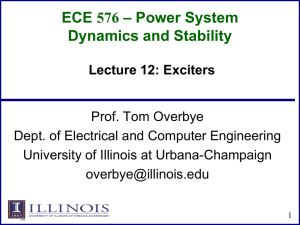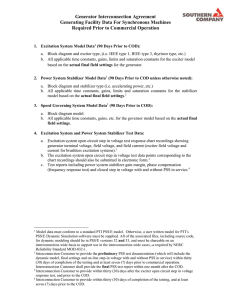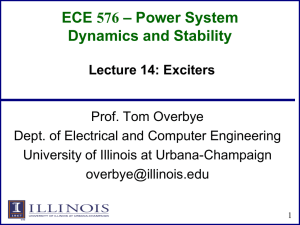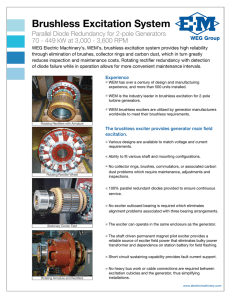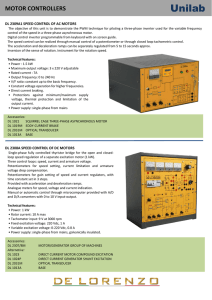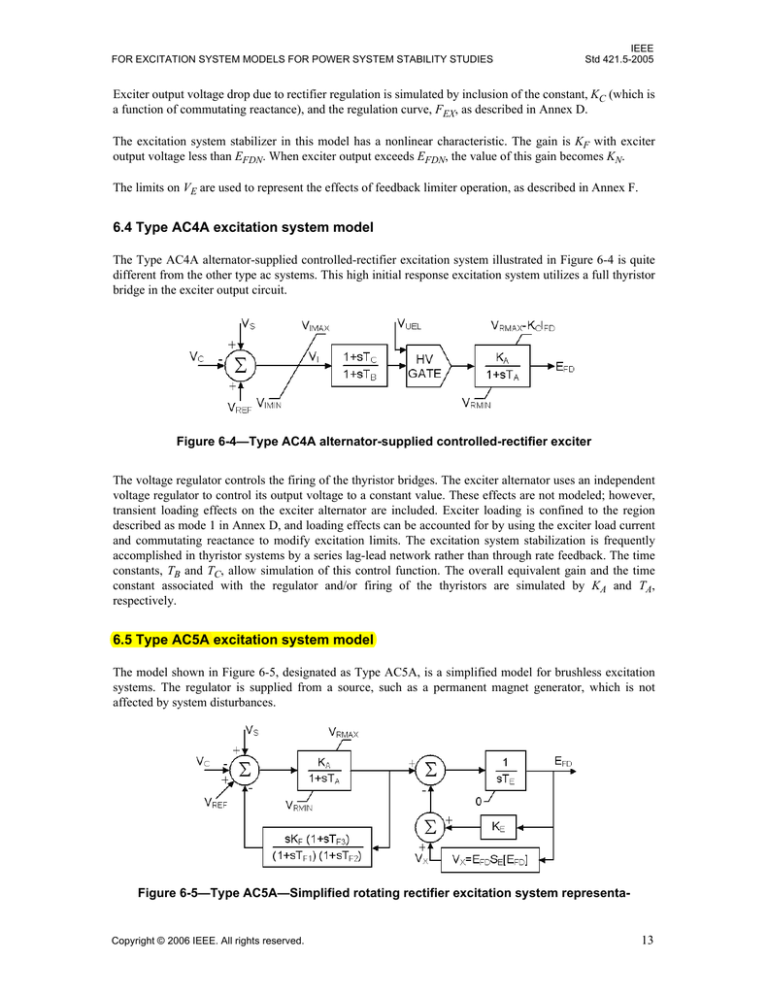
FOR EXCITATION SYSTEM MODELS FOR POWER SYSTEM STABILITY STUDIES
IEEE
Std 421.5-2005
Exciter output voltage drop due to rectifier regulation is simulated by inclusion of the constant, KC (which is
a function of commutating reactance), and the regulation curve, FEX, as described in Annex D.
The excitation system stabilizer in this model has a nonlinear characteristic. The gain is KF with exciter
output voltage less than EFDN. When exciter output exceeds EFDN, the value of this gain becomes KN.
The limits on VE are used to represent the effects of feedback limiter operation, as described in Annex F.
6.4 Type AC4A excitation system model
The Type AC4A alternator-supplied controlled-rectifier excitation system illustrated in Figure 6-4 is quite
different from the other type ac systems. This high initial response excitation system utilizes a full thyristor
bridge in the exciter output circuit.
Figure 6-4—Type AC4A alternator-supplied controlled-rectifier exciter
The voltage regulator controls the firing of the thyristor bridges. The exciter alternator uses an independent
voltage regulator to control its output voltage to a constant value. These effects are not modeled; however,
transient loading effects on the exciter alternator are included. Exciter loading is confined to the region
described as mode 1 in Annex D, and loading effects can be accounted for by using the exciter load current
and commutating reactance to modify excitation limits. The excitation system stabilization is frequently
accomplished in thyristor systems by a series lag-lead network rather than through rate feedback. The time
constants, TB and TC, allow simulation of this control function. The overall equivalent gain and the time
constant associated with the regulator and/or firing of the thyristors are simulated by KA and TA,
respectively.
6.5 Type AC5A excitation system model
The model shown in Figure 6-5, designated as Type AC5A, is a simplified model for brushless excitation
systems. The regulator is supplied from a source, such as a permanent magnet generator, which is not
affected by system disturbances.
Figure 6-5—Type AC5A—Simplified rotating rectifier excitation system representa-
Copyright © 2006 IEEE. All rights reserved.
13
IEEE
Std 421.5-2005
IEEE STANDARD
Unlike other ac models, this model uses loaded rather than open circuit exciter saturation data in the same
way as it is used for the dc models (Annex C).
Because the model has been widely implemented by the industry, it is sometimes used to represent other
types of systems when either detailed data for them are not available or simplified models are required.
6.6 Type AC6A excitation system model
The model shown in Figure 6-6 is used to represent field-controlled alternator-rectifier excitation systems
with system-supplied electronic voltage regulators. The maximum output of the regulator, VR, is a function
of terminal voltage, VT. The field current limiter included in the original model AC6A remains in the 2005
update of this document, although overexcitation and underexcitation limiters are now described more fully
in Clause 9 and Clause 10 respectively.
Figure 6-6—Type AC6A—Alternator-rectifier excitation system with non-controlled
rectifiers and system-supplied electronic voltage regulator
6.7 Type AC7B excitation system model
These excitation systems consist of an ac alternator with either stationary or rotating rectifiers to produce the
dc field requirements. Upgrades to earlier ac excitation systems, which replace only the controls but retain
the ac alternator and diode rectifier bridge, have resulted in this new model, as shown in Figure 6-7. Some of
the features of this excitation system include a high bandwidth inner loop regulating generator field voltage
or exciter current (KF2, KF1), a fast exciter current limit, VFEMAX, to protect the field of the ac alternator, and
the PID generator voltage regulator (AVR). An alternative rate feedback loop (KF, TF) is provided for
stabilization if the AVR does not include a derivative term. If a PSS control is supplied, the Type PSS2B or
PSS3B models are appropriate.
6.8 Type AC8B excitation system model
The block diagram of the AC8B model is shown in Figure 6-8. The AVR in this model consists of PID
control, with separate constants for the proportional (KPR), integral (KIR), and derivative (KDR) gains. The
values for the constants are chosen for best performance for each particular generator excitation system. The
representation of the brushless exciter (TE, KE, SE, KC, KD) is similar to the model Type AC2A. Sample data
for this model is shown in Annex H. The Type AC8B model can be used to represent static voltage
regulators applied to brushless excitation systems. Digitally based voltage regulators feeding dc rotating
14
Copyright © 2006 IEEE. All rights reserved.
IEEE
Std 421.5-2005
IEEE STANDARD
Annex A
(normative)
Nomenclature
Maximum and minimum limits of parameters are not shown explicitly in the nomenclature, but are
represented by the appropriate subscript (max or min) on the variable. A score line above a parameter is used
to indicate that it is a phasor.
A1–8
PSS signal conditioning frequency filter constants
ADJ_SLEW
Voltage adjuster travel time
EFD
Exciter output voltage
EFD1, EFD2
Exciter voltages at which exciter saturation is defined (dc commutator exciters and Type
AC5A models only)
EFDN
Value of EFD at which feedback gain changes (Type AC3A)
ESC
Speed change reference (Type DEC1A)
EXLON
Indication that overexcitation limiter is active
F1, F2
UEL terminal voltage multiplying factors
FEX
Rectifier loading factor, a function of IN
HV GATE
Model block with two inputs and one output, the output always corresponding to the
higher of the two inputs.
HYST
OEL pickup/drop-out hysteresis
IFD
Synchronous machine field current
IFDLIM
OEL timed field current limit
IFDMAX
OEL instantaneous field current limit
ILR
Exciter output current limit reference
IN
Normalized exciter load current
IRated
Rated field current
I T ,I T
Synchronous machine terminal current
ITFPU
OEL timed field current limiter pickup level
k1
UEL terminal voltage exponent applied to real power input to UEL limit look-up table
k2
UEL terminal voltage exponent applied to reactive power output from UEL limit look-up
table
KA
Voltage regulator gain
KAN
Discontinuous controller gain (Type DEC1A)
KB
Second stage regulator gain
42
Copyright © 2006 IEEE. All rights reserved.
FOR EXCITATION SYSTEM MODELS FOR POWER SYSTEM STABILITY STUDIES
IEEE
Std 421.5-2005
KB, KI, KH
Low, intermediate, and high band gains (Type PSS4B)
KC
Rectifier loading factor proportional to commutating reactance
KCD
OEL cooldown gain
KCI
Exciter output current limit adjustment (Type ST6B)
KD
Demagnetizing factor, a function of exciter alternator reactances
KE
Exciter constant related to self-excited field
KETL
Terminal voltage limiter gain (Type DEC1A)
KF, KF1, KF2,
KN
Excitation control system stabilizer gains
KFB
Gain associated with optional integrator feedback input signal to UEL
KFF
Pre-control gain constant of the inner loop field regulator (Type ST6B)
KG
Feedback gain constant of the inner loop field regulator (Type ST3A, ST6B)
KH
Exciter field current feedback gain (Type AC2A), exciter field current limiter gain (Type
AC6A)
KH1, KH2
High band differential filter gains (Type PSS4B)
KH11, KH17
High band first lead-lag blocks coefficients (Type PSS4B)
KI
Potential circuit gain coefficient
KI1, KI2
Intermediate band differential filter gains (Type PSS4B)
KI11, KI17
Intermediate band first lead-lag blocks coefficients (Type PSS4B)
KL, KI, KH
Low, intermediate, and high band gains (Type PSS4B)
KL1, KL2
Low band differential filter gains (Type PSS4B)
KL11, KL17
Low band first lead-lag blocks coefficients (Type PSS4B)
KLR
Exciter output current limiter gain
KM
Forward gain constant of the inner loop field regulator (Type ST3A, ST6B)
KN
Excitation system stabilizer gain (Type AC3A)
KP
Potential circuit gain coefficient
KPA, KIA
Voltage regulator proportional and integral gains (Type ST6B, AC7B)
KPM, KIM
Voltage regulator proportional and integral gains (Type ST4B)
KPR, KIR, KDR
Voltage regulator proportional, integral, and derivative gains (Type ST4B, AC7B, AC8B)
KR
Constant associated with regulator and alternator field power supply (Type AC3A)
KRAMP
OEL ramped limit rate
KS
PSS gain (Type PSS1A)
KS1, KS2, KS3
PSS gains (Type PSS2B, PSS3B)
Copyright © 2006 IEEE. All rights reserved.
43
FOR EXCITATION SYSTEM MODELS FOR POWER SYSTEM STABILITY STUDIES
T8
PSS filter time constant
TA, TB, TC,
TB1, TC1, TK
Voltage regulator time constants
TAN
Discontinuous controller time constant (Type DEC1A)
TD1
Discontinuous controller time constant (Type DEC2A)
TD2
Discontinuous controller washout time constant (Type DEC2A)
TDR
Reset time delay (Type DEC3A); lag time constant (Type AC7B, AC8B)
TE
Exciter time constant, integration rate associated with exciter control
TF
Excitation control system stabilizer time constant
TF2, TF3
Excitation control system stabilizer time constants (Type AC5A)
TG
Feedback time constant of inner loop field voltage regulator (Type ST6B)
T H, TJ
Exciter field current limiter time constants
TH1, TH2, …,
TH12
High band time constants (Type PSS4B)
TI1, TI2, …, TI12
Intermediate band time constants (Type PSS4B)
TK
Regulator lead time constant (Type AC6A)
TL, TI, TH
Low, intermediate, and high band time constants (Type PSS4B)
IEEE
Std 421.5-2005
TL1, TL2, …, TL12 Low band time constants (Type PSS4B)
TM
Forward time constant of inner loop field regulator (Type ST3A)
TOFF
Time adjuster change signal is off
TON
Time adjuster change signal is on
TPFC
PF controller time delay
TR
Regulator input filter time constant
TRH
Rheostat travel time (Type DC3A)
TU1, TU3
UEL lead time constants
TU2, TU4
UEL lag time constants
TUL
Time constant associated with optional integrator feedback input signal to UEL
TUP
UEL real power filter time constant
TUQ
UEL reactive power filter time constant
TUV
UEL voltage filter time constant
TVARC
Var controller time delay
TW1, TW2, TW3,
TW4, TW5
PSS and DEC washout time constants
VA
Regulator internal voltage
Copyright © 2006 IEEE. All rights reserved.
45
IEEE
Std 421.5-2005
IEEE STANDARD
Annex C
(normative)
Exciter saturation and loading effects
The exciter saturation function SE[EFD] is defined as a multiplier of pu exciter output voltage to represent
the increase in exciter excitation requirements due to saturation. Figure C.1 illustrates the calculation of a
particular value of SE[EFD]. At a given exciter output voltage, the quantities A, B, and C are defined as the
exciter excitation required to produce that output voltage on the constant-resistance-load saturation curve,
on the air-gap line, and on the no-load saturation curve, respectively. The constant-resistance-load saturation
curve is used in defining SE for all dc-commutator exciters and for ac exciters represented by the simplified
AC5A model. For the loaded saturation representation, SE[EFD] is given by Equation (C.1):
A–B
S E [ E FD ] = ------------B
(C.1)
Figure C.1—Exciter saturation characteristics
Note that when exciter field resistance is significantly different from exciter base resistance, an adjusted
value of SE, may be used as described in Annex A of the IEEE Committee Report [B20].
The no-load saturation curve is used in defining SE[VE] for alternator-rectifier exciters (except for Type
AC5A). Here SE[VE] is given by Equation (C.2):
C–B
S E [ V E ] = ------------B
(C.2)
The no-load saturation curve for alternator-rectifier exciters is used because exciter regulation effects are
accounted for by inclusion of a demagnetizing factor, KD, and commutating reactance voltage drops in the
model (see Annex D).
50
Copyright © 2006 IEEE. All rights reserved.
FOR EXCITATION SYSTEM MODELS FOR POWER SYSTEM STABILITY STUDIES
IEEE
Std 421.5-2005
Different computer programs have represented the exciter saturation characteristic with different
mathematical expressions. In general, the saturation function can be defined adequately by two points. To be
consistent, the procedure suggested is to establish two voltages at which to specify SE and then use these
data for computer input. The form of the saturation function is not defined here, but rather considered to be a
part of the particular computer program used.
In general, the following would be specified:
Saturation function
designation
DC-commutator
exciter voltage
SE[EFD1]
EFD1
SE[EFD2]
EFD2
Alternator-rectifier
exciter voltage
SE[VE1]
VE1
SE[VE2]
VE2
Since saturation effects are most significant at higher voltages, the voltage, EFD1, for which SE[EFD1] is
specified, should be near the exciter ceiling voltage, and the voltage, EFD2, for which SE[EFD2] is specified,
should be at a lower value, commonly near 75% of EFD1. In providing saturation data, the voltages EFD1 and
EFD2 should be specified along with the corresponding saturation data.
Similarly, for the alternator-rectifier exciters, the voltage, VE1, for which SE[VE1] is specified, should be
near the exciter open circuit ceiling voltage and the voltage VE2, for which SE[VE2] is specified, should be a
lower value, commonly near 75% of VE1. In providing saturation data, the voltages, VE1 and VE2, should be
specified along with the corresponding saturation data.
In some cases, e.g., a self-excited dc exciter, the ceiling voltage may not be precisely known because it
depends on KE. In such cases, SE[EFD1] corresponds to a specified value of exciter voltage near its expected
maximum value.
Copyright © 2006 IEEE. All rights reserved.
51
FOR EXCITATION SYSTEM MODELS FOR POWER SYSTEM STABILITY STUDIES
IEEE
Std 421.5-2005
H.9 Sample data for a Type AC5A excitation system
Terminal voltage transducer:
TR = 0; RC = 0; XC = 0
KA = 400
KE = 1.0
KF = 0.03
TA = 0.02
SE[EFD1] = 0.86
TF1 = 1.0
VRMAX = 7.3
EFD1 = 5.6
TF2 = TF3 = 0
VRMIN = –7.3
SE[EFD2] = 0.5
TE = 0.8
EFD2 = 0.75 × EFD1
H.10 Sample data for a Type AC6A excitation system
Terminal voltage transducer:
TR = 0.02; RC = 0; XC = 0
Exciter
KA = 536
TJ = 0.02
VHMAX = 75
TA = 0.086
KD = 1.91
VFELIM = 19
TB = 9.0
KC = 0.173
SE[VE1] = 0.214
TC = 3.0
KE = 1.6
VE1 = 7.4
TK = 0.18
VAMAX = 75
SE[VE2] = 0.044
KH = 92
VAMIN = –75
VE2 = 5.55
TE = 1.0
VRMAX = 44
TH = 0.08
VRMIN = –36
Type PSS2A stabilizer parameters with speed and electrical power input
KS1 = 20
M=2
KS2 = 1.13 = T7/2H
N=4
KS3 = 1
VSTMAX = 0.20
T1 = T3 = 0.16
VSTMIN = –0.066
T2 = T4 = 0.02
T6 = 0
H = synchronous machine inertia constant
T7 = 10.0
TW1 = TW2 = TW3 = 10
T8 = 0.3
TW4 = 0
T9 = 0.15
Copyright © 2006 IEEE. All rights reserved.
69
FOR EXCITATION SYSTEM MODELS FOR POWER SYSTEM STABILITY STUDIES
IEEE
Std 421.5-2005
Annex I
(informative)
Manufacturer model cross reference
The following information is given for the convenience of users of this recommended practice and does not
constitute an endorsement by the IEEE of these products.
At the time IEEE Std 421.5-2005 was approved, the following examples of equivalent excitation systems
were supplied by other manufacturers. The IEEE will make available at no charge to the users of this
recommended practice, IEEE Std 421.5-2005, an up-to-date listing of examples of equivalent excitation
systems supplied by other manufactures. This list will be made available at the IEEE Web site.
Type
Examples
DC1A
Regulex is a trademark of Allis Chalmers Corp. Amplidyne and GDA are trademarks of General
Electric Co. Westinghouse Mag-A-Stat, Rototrol, Silverstat, and TRA. AB and KC are trademarks of
Asea Brown Boveri Inc. The type KC may be modeled with some approximations.
DC2A
Westinghouse PRX-400. General Electric SVR. Eaton Cutler Hammer/Westinghouse type WDR
retrofit.
DC3A
GFA 4 is a trademark of General Electric Co. Westinghouse BJ30.
DC4B
Basler DECS or Eaton/Cutler Hammer ECS2100 applied to a dc commutator exciter.
AC1A
Westinghouse Brushless Excitation System; Cutler Hammer Westinghouse WDR brushless exciter
retrofit.
AC2A
Westinghouse High Initial Response Brushless excitation system.
AC3A
ALTERREX is a trademark of General Electric Co.
AC4A
ALTHYREX is a trademark of General Electric Co.; General Electric Rotating Thyristor Excitation
system.
AC5A
This model can be used to represent small excitation systems such as those produced by Basler and
Electric Machinery.
AC6A
Stationary diode systems such as those produced by C.A. Parsons.
AC7B
Basler DECS and EATON ECS2100 applied to ac/dc rotating exciters; Brush PRISMIC A50-B, GE
EX2000/2100, SIEMENS RG3, and THYRISIEM brushless excitation. Voltage regulator
replacements for GE Alterrex (Type AC3A model) or dc exciters. DECS is a trademark of Basler
Electric Co. Brush and PRISMIC are trademarks of FKI plc. RG3 and THYRISIEM are registered
trademarks of Siemens AG.
AC8B
Basler DECS and Brush PRISMIC A30 and A10.
ST1A
Silcomatic (a trademark of Canadian General Electric Co.). Westinghouse Canada Solid State
Thyristor Excitation System; Westinghouse Type PS Static Excitation System with Type WTA,
WTA-300, and WHS voltage regulators. Static excitation systems by ALSTOM, ASEA, Brown
Boveri, GEC-Eliott, Hitachi, Mitsubishi, Rayrolle-Parsons, and Toshiba. General Electric Potential
Source Static Excitation System. Basler Model SSE. UNITROL (a registered trademark of Asea
Brown Boveri, Inc.); THYRIPOL (a registered trademark of Siemens AG.); Westinghouse WDR and
MGR.
ST2A
General Electric static excitation systems, frequently referred to as the SCT-PPT or SCPT.
Copyright © 2006 IEEE. All rights reserved.
81

